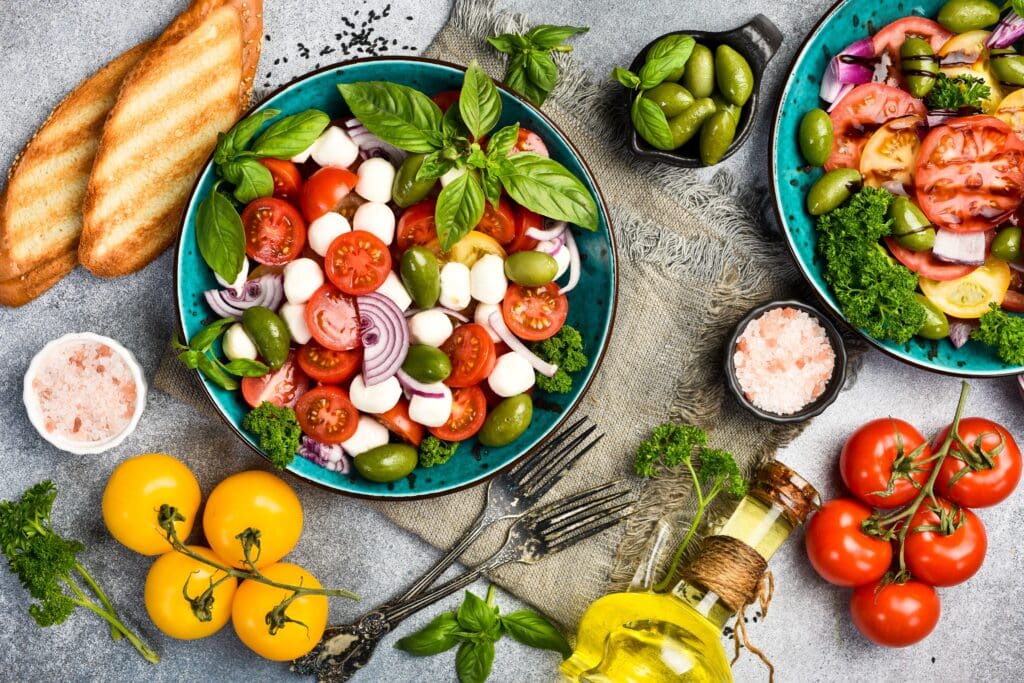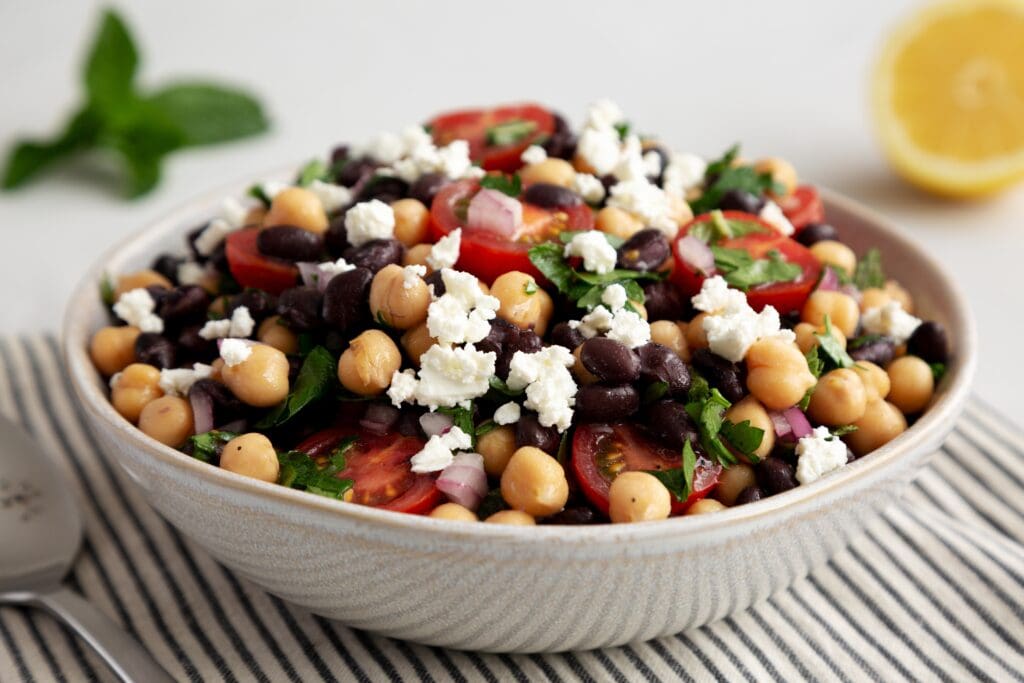July 22, 2025
Eat Well and Lose Weight the Mediterranean Way
After a wonderful week in Corfu, I’ve come home feeling inspired to bring more Mediterranean-style cooking into my weekly meals. The vibrant flavors, fresh ingredients, and simple approach to food left a lasting impression on me. Beyond being delicious, this way of eating is also a powerful tool for supporting a healthy lifestyle, it’s naturally balanced, nourishing, and an enjoyable way to manage your weight without restriction.
The Simplicity of the Mediterranean Diet
One of the best things about eating the Mediterranean way is how simple and accessible it is. Most of the ingredients can be found in your local supermarket or greengrocer, and the focus is on wholesome, unrefined produce.

Key Ingredients of the Mediterranean Way
This way of eating centres around:
- Plenty of fresh vegetables and fruit
- Healthy fats like olive oil
- Protein-rich fish, beans, and nuts
- Whole grains like brown rice and quinoa
- Flavourful additions like garlic, herbs, and seeds
- Minimal red meat and processed foods
Key Benefits of the Mediterranean Diet for Weight Loss
Naturally Reduces Calorie Intake
The diet emphasises whole, nutrient-dense foods like vegetables, fruits, legumes, and whole grains, which are high in fibre and water content. These help you feel full on fewer calories, making it easier to maintain a calorie deficit without strict portion control.
Rich in Healthy Fats
Unlike low-fat diets, the Mediterranean approach includes heart-healthy fats from olive oil, nuts, and fish. These fats keep you full, stabilise blood sugar, and reduce cravings, making it easier to avoid processed snacks and overeating.
Low in Processed Foods and Added Sugars
By focusing on fresh, unprocessed ingredients and cutting out sugary drinks, packaged snacks, and refined carbs, the diet naturally helps you reduce empty calories and improve insulin sensitivity, both of which support weight loss.
Encourages Mindful, Enjoyable Eating
Meals are often eaten slowly, socially, and with intention a cultural aspect of Mediterranean living. This helps you become more in tune with hunger cues and promotes a healthier relationship with food, which can lead to more sustainable weight loss.
Sustainable Long-Term Approach
Unlike restrictive diets, the Mediterranean diet is flexible, flavourful, and varied making it easier to stick to long-term. This consistency is key to maintaining a healthy weight over time.
Supports Gut Health & Metabolism
The high fibre content from vegetables, legumes, and whole grains supports a healthy gut microbiome, which plays a role in metabolism, inflammation, and even weight regulation.
An Easy Way to Embrace the Med Diet – A Greek-Inspired Bowl
Having just returned from the beautiful island of Corfu, I felt inspired to bring the Mediterranean way of eating into my everyday routine. One of the simplest and most delicious ways to do this is with a Greek Buddha Bowl a vibrant, nutritious, and incredibly versatile dish that captures the essence of Mediterranean flavors.
It’s easy to prepare, packed with fresh ingredients, and perfect for a wholesome lunch or light dinner. Best of all, it’s completely adaptable: you can mix and match with whatever you have in your fridge or cupboard, making it both practical and satisfying.
Key Ingredients
A typical Greek Buddha bowl includes:
- Base: Leafy greens like spinach or mixed greens.
- Grains: Options like couscous, quinoa, or orzo.
- Protein: Chickpeas are commonly used, but you can also add feta cheese or other legumes.
- Vegetables: Fresh vegetables such as cucumbers, cherry tomatoes, roasted sweet potatoes, and courgette.
- Healthy Fats: Kalamata olives and avocado are great additions.
- Dressing: A simple dressing made from olive oil, lemon juice, garlic, and herbs like parsley or dill, or a creamy tzatziki sauce for extra flavour.
Greek Buddha Bowl Recipe

Servings: 2 bowls
Prep Time: 20 minutes
Cook Time: 15 minutes
Ingredients:
Base:
- 1 cup cooked quinoa (or brown rice or couscous) – you can also buy prepared grains in packets such as Merchant Gourmet
- 1 cup chopped lettuce or mixed greens
Protein:
- 1 cup chickpeas (cooked or canned, drained and rinsed) or salmon fillet freshly cooked or pre bought
- Optional: ½ tsp olive oil, ½ tsp smoked paprika, pinch of salt (for roasting the chickpeas)
Veggies:
- ½ cucumber, diced
- 1 cup cherry tomatoes, halved
- ½ red onion, thinly sliced
- ½ red pepper or red cabbage, sliced
- ¼ cup kalamata olives, sliced
- ¼ avocado, sliced
Extras:
- ¼ cup crumbled feta cheese
- Fresh parsley or dill for garnish
- Lemon wedges for serving
Lemon-Tahini Greek Dressing (or just use Olive oil)
- 2 tbsp tahini
- 1 tbsp olive oil
- 1 clove garlic, finely minced
- Juice of 1 lemon
- 1 tsp red wine vinegar
- ½ tsp dried oregano
- Salt and pepper to taste
- Water to thin (1–3 tbsp, as needed)
Instructions:
Cook the Grain:
Prepare quinoa or other grain according to package instructions. Set aside to cool slightly.
Optional Roasted Chickpeas
Toss chickpeas with olive oil, paprika, and a pinch of salt. Roast at 200°C for 15–20 minutes for extra crunch.
Optional Oven-Cooked Salmon Fillet
Season and drizzle the salmon fillets with olive oil. Add lemon slices and herbs on top if desired.
Bake at 180°C for 12–15 minutes depending on thickness (thicker fillets take longer).
Make the Dressing:
Whisk all dressing ingredients in a small bowl. Add water a little at a time to reach desired consistency (creamy but pourable).
Assemble the ingredients and enjoy.
If you want a more personalised plan we can support you with our nutrition health coaching program, Click here to book a FREE 15 minute discovery call.